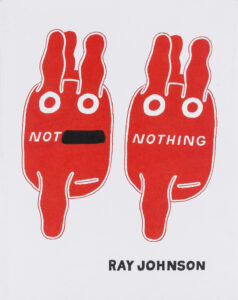Not Nothing – siglio (original) (raw)
Not NothingSelected Writings, 1954–1994
Ray Johnson
Edited by Elizabeth Zuba with an essay by Kevin Killian
add to cart

$45.00
low stock
Click here for holiday discount codes (20-30%) but, alas, no guaranteed delivery by Christmas.
or, use code “turnthepage” for 15% off this title
paperback 8.25 × 10 in.
380 pages, b/w and color
978-1-938221-04-0
published in 2014
[Not Nothing] crackles with intellectual energy, with enough drawings and mini-collages embedded in its reproduced texts to hold even a nonreader’s attention. Most important, it fills out the picture of what and who Johnson was: a brilliant, uncontainable polymath, an artist-poet, the genuine item.
—Holland Cotter, New York Times
Ray Johnson, considered the progenitor of Correspondence art, blurred the boundaries between life and art, authorship and intimacy. The defining nature of his work were his letters (often both visual and textual in character), intended to be received, replied to (altered and embellished) and read, again and again. This lovingly curated collection of more than 200 mostly previously unpublished writings—including selected letters, minutes for “New York Correspondence School” meetings, hand-written notes and other writings—opens a new view into the whirling flux of Johnson’s art, highlighting his keen sense of play as well as his attuned sensitivity to both language and the shifting nature of meaning. Cumulatively, the writings reveal not only how he created relationships, glyphs and puzzles by connecting words, phrases, people and ideas, but also something about the elusive Johnson himself.
Not Nothing: Selected Writings by Ray Johnson is but one possible selection from thousands of pieces from the Ray Johnson Estate archives. In this chronological presentation, editor Elizabeth Zuba’s intention is to make space for thoroughly experiencing a pervasive and often overlooked aspect of Johnson’s work: language. With near full-size reproductions of the original pages in color and half-tones, the works in Not Nothing: Selected Writings by Ray Johnson can be easily read—and are revelatory in their diverse but porous modes and in the way they deepen the understanding of Johnson’s entire oeuvre.
excerpts from editor Elizabeth Zuba’s introduction and contributor Kevin Killian’s essay. Zuba converses with Clive Phillpot at BOMB and Killian talks to Andrew Blackley at 3 a.m. about Johnson.
Make room for Ray Johnson, whose place in history has been only vaguely defined. Johnson’s beguiling, challenging art has an exquisite clarity and emotional intensity that makes it much more than simply a remarkable mirror of its time, although it is that, too.
—Roberta Smith, New York Times
RAY JOHNSON (1927–1995), continues to be revealed as one of the most quietly consequential figures in American contemporary art. An influential pioneer of Pop art, Conceptual art and Mail art (though he eschewed all of these monikers), Johnson’s extrasensory perception and insatiable curiosity resulted in an immense body of work that spans collage, correspondence, performance, sculpture, drawing, painting and book arts. A graduate of Black Mountain College (1945-48), Johnson also created an alternative network of collaborative art known as “The New York Correspondence School” in 1968, and is considered the founder of Mail Art. Despite sharing major exhibitions between 1957-1978 (with the likes of Duchamp, Jasper Johns, Robert Rauschenberg, Allan Kaprow and Andy Warhol, among others) as well as having important solo shows at major galleries and museums (such as at The Whitney in 1970), Johnson systematically refused or flouted most opportunities to popularize his work through mainstream art commerce. On January 13, 1995 Johnson leapt from the Sag Harbor bridge in Long Island in an apparent suicide.
ELIZABETH ZUBA has edited or translated several books of artists’ writings including My Ogre Book, Shadow Theater, Midnight by Marcel Broodthaers (Siglio) and Ray Johnson’s Art World (Feigen & Co.) She is also the author of two works of poetry.
The anticipation of opening an envelope before reading a letter, the shape of the words before their comprehension, the nothing before the something—these are the experiential locales that his art maps with aptly fluid boundaries. His work is self-regarding and hermetic, to be sure, but Johnson’s interiority is carefully positioned just—but not quite—out of reach. To appreciate the joke, you have to not try. It’s like the mail: It comes when it does. And then you get it.
—Albert Mobilio, Bookforum
While Not Nothing will make absorbing reading for those interested in mail art, Fluxus, Pop, Conceptualism, the legacies of Dada and Surrealism, the reception of Duchamp, or the downtown New York scene in the years spanned by Zuba’s selection, the two books [with The Paper Snake] will likewise be a pleasure for anyone beguiled by language-and-image as a field of play.
—Frances Richard, Hyperallergic
More fantastic press about Not Nothing and The Paper Snake: an appreciation by Gary Panter at The Paris Review, a review by Marjorie Perloff at The Times Literary Supplement, and more at Artillery, Los Angeles Review of Books, Los Angeles Times, Poets & Writers, Utne Reader, and Vanity Fair.
Call It Something Else, an exhibition about Dick Higgins’ Something Else Press, at the Reina Sofia Museum in Madrid runs September 27, 2023 through January 22, 2024.
see also
✼ natalie’s upstate weather report:
May 27, 2024—Eggs, books, etc.: The first book in siglio’s new habitat is just about laid. Our local snapping turtle George perambulated the house in driving rain, determined and curious, then laid her eggs at our doorstep. Do snapping turtles and publishers share common traits? Oh, so very, very slow. Reportedly testy but actually timid. A group of them might be a bale, nest, turn, dole, or creep—though ours seems solitary. Only 10% of her eggs will survive as hatchlings. Make of it what you will. Sophie Calle’s The Sleepers goes on press very soon. One sleeper said to Calle: “I’ve often dreamt of an egg that was enormous ovoid transgression. The original sin of Adam & Eve is a hard-boiled egg.” Meanwhile, many sightings of goslings, kits, poults, and one fawn too: how easily the others propagate, alas.
[...]